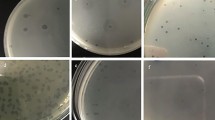Abstract
Persistent urinary tract infections (UTI) are often caused by E. coli adhered to urothelium. This type of cells is generally recognized as very tolerant to antibiotics which renders difficult the treatment of chronic UTI. This study investigates the use of lytic bacteriophages as alternative antimicrobial agents, particularly the interaction of phages with E. coli adhered to urothelium and specifically determines their efficiency against this type of cells. The bacterial adhesion to urothelium was performed varying the bacterial cell concentrations and the period and conditions (static, shaken) of adhesion. Three collection bacteriophages (T1, T4, and phiX174 like phages) were tested against clinical E. coli isolates and only one was selected for further infection experiments. Based on the lytic spectrum against clinical isolates and its ability to infect the highest number of antibiotic resistant strains, the T1-like bacteriophage was selected. This bacteriophage caused nearly a 45% reduction of the bacterial population after 2 h of treatment. This study provides evidence that bacteriophages are effective in controlling suspended and adhered cells and therefore can be a viable alternative to antibiotics to control urothelium- adhered bacteria.




Similar content being viewed by others
References
Lepape A, Monnet DL (2009) Experience of European intensive care physicians with infections due to antibiotic-resistant bacteria. Euro Surveill 14:1–3
Atterbury RJ, Van Bergen MA, Ortiz F, Lovell MA, Harris JA, De BA, Wagenaar JA, Allen VM, Barrow PA (2007) Bacteriophage therapy to reduce salmonella colonization of broiler chickens. Appl Environ Microbiol 73:4543–4549
Huff WE, Huff GR, Rath NC, Donoghue AM (2006) Evaluation of the influence of bacteriophage titer on the treatment of colibacillosis in broiler chickens. Poult Sci 85:1373–1377
Loc Carrillo C, Atterbury RJ, el-Shibiny A, Connerton PL, Dillon E, Scott A, Connerton IF (2005) Bacteriophage therapy to reduce Campylobacter jejuni colonization of broiler chickens. Appl Environ Microbiol 71:6554–6563
Wagenaar JA, Van Bergen MA, Mueller MA, Wassenaar TM, Carlton RM (2005) Phage therapy reduces Campylobacter jejuni colonization in broilers. Vet Microbiol 109:275–283
Krylov VN (2001) Phage therapy in terms of bacteriophage genetics: hopes prospects safety limitations. Russian J Genet 37:715–730
Weber-Dabrowska B, Dabrowski M, Slopek S (1987) Studies on bacteriophage penetration in patients subjected to phage therapy. Arch Immunol Ther Exp 35:563–568
Nishikawa H, Yasuda M, Uchiyama J, Rashel M, Maeda Y, Takemura I, Sugihara S, Ujihara T, Shimizu Y, Shuin T, Matsuzaki S (2008) T-even-related bacteriophages as candidates for treatment of Escherichia coli urinary tract infections. Arch Virol 153:507–515
Champagne CP, Gardner N (1995) The spot test method for the in-plant enumeration of bacteriophages with paired cultures of Lactobacillus delbrueckii subsp bulgaricus and Streptococcus salivarius subsp. thermophilus. Int Dairy J 5:417–425
Adams MH (1959) Bacteriophages. Interscience Publishers, New York
Domann E, Hong G, Imirzalioglu C, Turschner S, Kuhle J, Watzel C, Hain T, Hossain H, Chakraborty T (2003) Culture-independent identification of pathogenic bacteria and polymicrobial infections in the genitourinary tract of renal transplant recipients. J Clin Microbiol 41:5500–5510
Pezzlo M (1988) Detection of urinary tract infections by rapid methods. Clin microbiol Rev 1:268–280
Healey MC, Hwang HH, Elsner YY, Johnston AV (1991) A model for demonstrating the adhesion of actinobacillus-seminis to epithelial-cells. Canadian J Veter Res 55:121–127
Finlay BB, Falkow S (1997) Common themes in microbial pathogenicity revisited. Microbiol Mol Biol Rev 61:136–139
Mulvey MA, Schilling JD, Hultgren SJ (2001) Establishment of a persistent Escherichia coli reservoir during the acute phase of a bladder infection. Infect Immun 69:4572–4579
Schilling JD, Lorenz RG, Hultgren SJ (2002) Effect of trimethoprim-sulfamethoxazole on recurrent bacteriuria and bacterial persistence in mice infected with uropathogenic Escherichia coli. Infect Immun 70:7042–7049
Cerca N, Martins S, Cerca F, Jefferson KK, Pier GB, Oliveira R, Azeredo J (2005) Comparative assessment of antibiotic susceptibility of coagulase-negative staphylococci in biofilm versus planktonic culture as assessed by bacterial enumeration or rapid XTT colorimetry. J Antimicrob Chemother 56:331–336
Cerca N, Martins S, Sillankorva S, Jefferson KK, Pier GB, Oliveira R, Azeredo J (2005) Effects of growth in the presence of subinhibitory concentrations of dicloxacillin on Staphylococcus epidermidis and Staphylococcus haemolyticus biofilms. Appl Environ Microbiol 71:8677–8682
Costa AR, Henriques M, Oliveira R, Azeredo J (2009) The role of polysaccharide intercellular adhesin (PIA) in Staphylococcus epidermidis adhesion to host tissues and subsequent antibiotic tolerance. Eur J Clin Microbiol Infect Dis 28:623–629
Ceri H, Olson ME, Stremick C, Read RR, Morck D, Buret A (1999) The calgary biofilm device: new technology for rapid determination of antibiotic susceptibilities of bacterial biofilms. J Clin Microbiol 37:1771–1776
Stewart PS, Costerton JW (2001) Antibiotic resistance of bacteria in biofilms. Lancet 358:135–138
Author information
Authors and Affiliations
Corresponding author
Rights and permissions
About this article
Cite this article
Sillankorva, S., Oliveira, D., Moura, A. et al. Efficacy of a Broad Host Range Lytic Bacteriophage Against E. coli Adhered to Urothelium. Curr Microbiol 62, 1128–1132 (2011). https://doi.org/10.1007/s00284-010-9834-8
Received:
Accepted:
Published:
Issue Date:
DOI: https://doi.org/10.1007/s00284-010-9834-8




